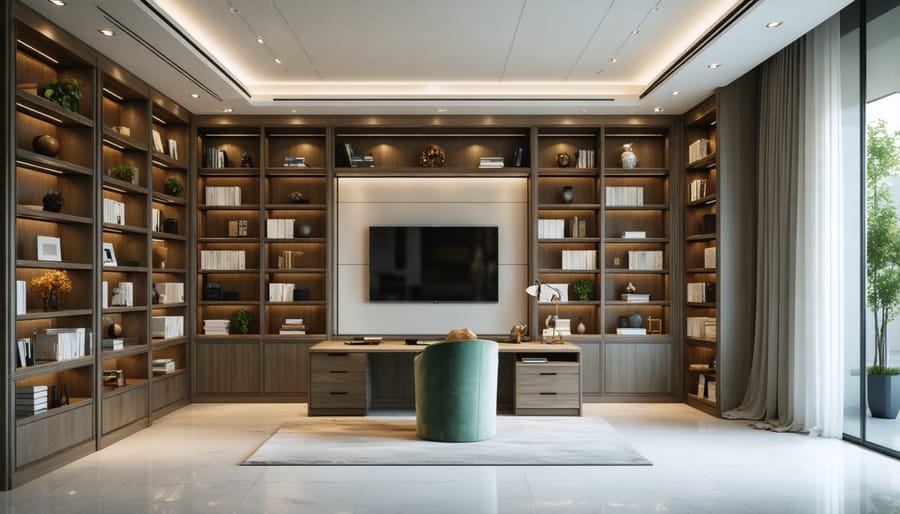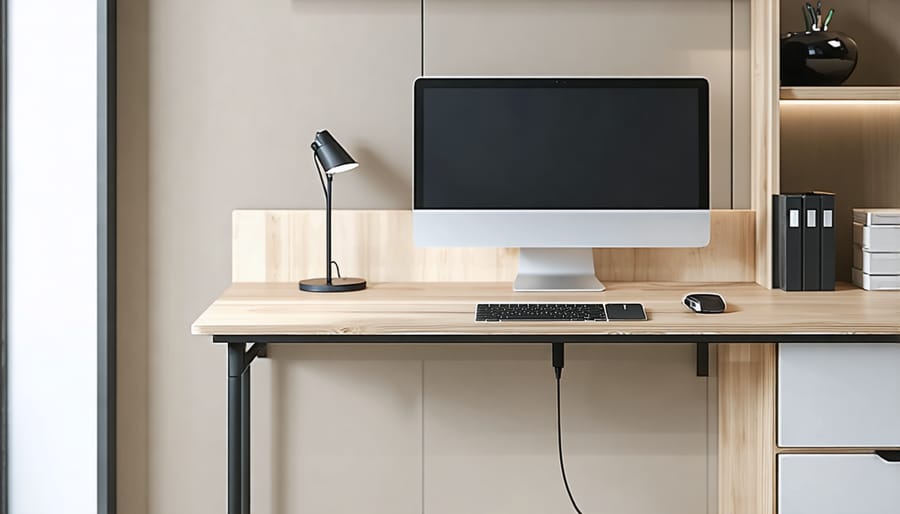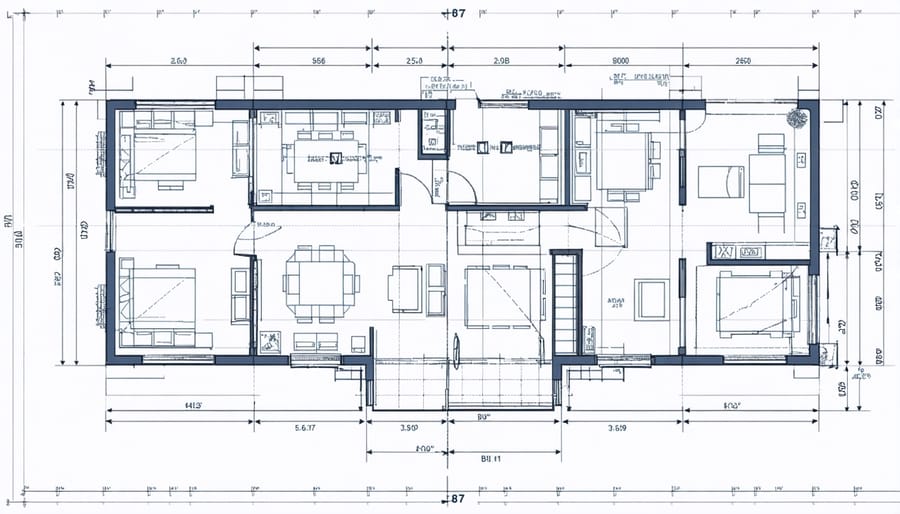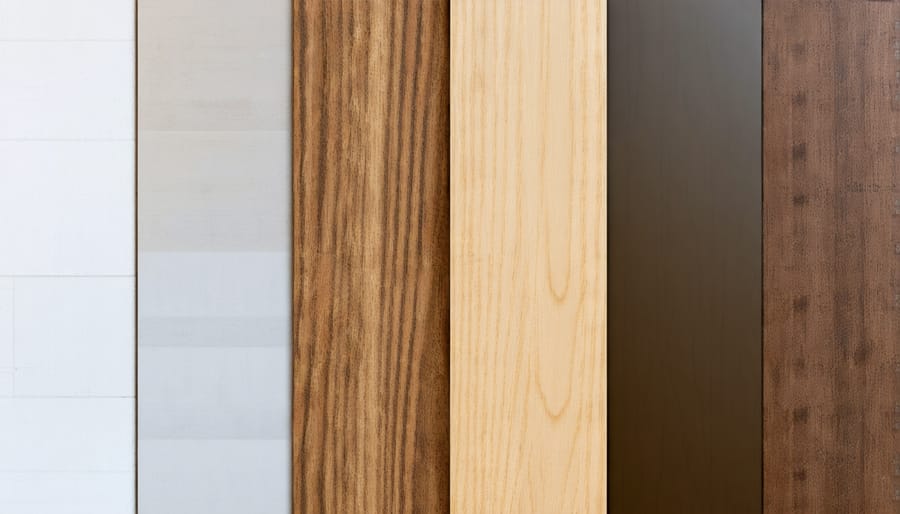Transform your home office into a productivity powerhouse with custom built-ins that maximize every square inch of available space. Modern smart office furniture solutions paired with thoughtfully designed built-ins create a seamless workspace that adapts to your unique needs. Built-in office solutions deliver unmatched organization while increasing your home’s value, offering the perfect blend of form and function for today’s remote work environment.
From floor-to-ceiling bookcases that showcase your professional library to hidden storage compartments that keep office supplies out of sight, built-ins transform ordinary walls into hardworking assets. Whether you’re retrofitting a spare bedroom or carving out a dedicated workspace in your living room, these permanent fixtures create a professional atmosphere that separates work life from home life—all while maintaining the aesthetic harmony of your home’s interior design.
Why Built-Ins Are Perfect for Your Home Office

Space Efficiency Benefits
Built-ins are the secret weapon to transform your home workspace into a storage powerhouse. By utilizing the full height of your walls, built-ins maximize every inch of vertical space that traditional furniture often leaves untouched. Think floor-to-ceiling shelving that turns dead wall space into a organized haven for books, files, and office supplies.
What’s particularly clever about built-ins is their ability to tackle those tricky architectural features that standard furniture can’t handle. Sloped ceilings, awkward corners, and spaces under windows become prime real estate for custom storage solutions. A built-in desk that wraps around a corner, for instance, creates a continuous workspace while making use of otherwise wasted space.
These custom installations can incorporate a mix of open shelving, closed cabinets, and drawer systems that adapt perfectly to your specific needs. By building upward instead of outward, you’ll free up valuable floor space while creating an organized, clutter-free environment that helps boost productivity and maintains a professional appearance in your home office.
Storage Solutions That Make Sense
Every home office has unique storage needs, and that’s where custom built-ins truly shine. Think about incorporating a mix of open shelving for frequently accessed items and closed cabinets for hiding office supplies and paperwork. Pull-out filing drawers can be seamlessly integrated into lower cabinets, while adjustable shelving allows you to modify storage spaces as your needs change.
Consider adding specialized storage solutions like vertical file organizers, dedicated printer shelves with cable management, or custom-sized cubbies for specific equipment. A combination of deep and shallow drawers helps separate small items from larger supplies, while built-in mail sorting stations keep incoming correspondence organized.
Don’t forget about often-overlooked spaces – the area above your desk can feature floating shelves for reference materials, while corner spaces can be transformed into floor-to-ceiling storage towers. For those who need to hide their workspace after hours, consider incorporating sliding doors or cabinet fronts that can conceal your entire desk area when not in use.
Remember to plan for future needs by including extra storage capacity and versatile organization systems that can adapt as your work habits evolve.
Essential Elements of Home Office Built-Ins
Desk Configuration Options
When planning your built-in desk configuration, start by considering your work style and space requirements. The classic straight desk layout offers simplicity and maximizes wall space, perfect for those who prefer a focused workspace. For corner installations, an L-shaped desk configuration provides additional surface area and can help separate different work zones – perhaps one side for computer work and another for paperwork or creative tasks.
Consider incorporating varied desk heights to accommodate different activities. A standard desk height of 29-30 inches works well for most tasks, but you might want to include a standing-height section (around 42 inches) for improved ergonomics and versatility. Some homeowners opt for adjustable-height mechanisms, though these require more complex installation.
Think about the depth of your workspace too. While 24 inches is standard, creative professionals might prefer 30 inches or more to accommodate larger monitors or drawing space. Don’t forget to plan for cable management – built-in solutions like discrete channels or grommets keep technology tidy and accessible.
For multi-person households, a double desk configuration can create separate workstations while maintaining a cohesive look. Consider adding a central shared storage section between workspaces for efficient use of space. Remember to include adequate legroom (at least 24 inches wide) for each seating area and factor in chair movement space to ensure comfort during long work sessions.
Shelving and Cabinet Combinations
Creating the perfect balance between open and closed storage is crucial for a functional and aesthetically pleasing home office. Open shelving displays your books, awards, and decorative items while providing easy access to frequently used materials. Meanwhile, cabinets keep office supplies, files, and less attractive necessities neatly tucked away from view.
Consider implementing a mix of both storage types based on your specific needs. A good rule of thumb is to aim for a 60/40 split between open and closed storage. For example, use upper open shelving to showcase professional books and meaningful objects, while lower cabinets can house printers, paper supplies, and archived files.
When designing your combination, think vertically. Floor-to-ceiling installations maximize storage space and create an impressive built-in look. Try incorporating adjustable shelving systems that allow you to modify compartment sizes as your needs change over time.
Don’t forget about incorporating different shelf depths. Deeper bottom cabinets can accommodate larger items, while shallower upper shelves prevent dust accumulation and maintain a clean appearance. Adding features like pull-out filing systems in lower cabinets or display lighting for upper shelves can enhance both functionality and visual appeal.
Remember to factor in your daily workflow when planning your storage layout. Keep frequently accessed items at arm’s reach in open shelving, while storing occasional-use supplies behind cabinet doors. This thoughtful organization will help maintain a clutter-free and efficient workspace.
Tech Integration Features
Modern home offices demand seamless tech integration, and today’s built-ins are rising to the challenge. The key to a truly functional workspace lies in incorporating charging stations and smart cable management solutions that keep your tech organized and readily accessible.
Consider installing built-in USB ports and power outlets at desk level, eliminating the need to crawl under furniture to plug in devices. Wireless charging pads can be seamlessly integrated into your desktop surface, creating a clean, cord-free aesthetic while keeping your devices powered up.
Cable management is crucial for maintaining a clutter-free environment. Built-in wire grommets and dedicated cable channels help route cords behind cabinets and through walls, while pull-out keyboard trays with integrated cable management keep your workspace tidy. Some modern built-ins even feature dedicated tech drawers with built-in charging stations and cable organizers.
Don’t forget about connectivity needs – consider incorporating ethernet ports and dedicated spaces for routers and modems. Many homeowners are also adding smart home automation features like voice-controlled lighting and motorized window treatments to enhance productivity.
For video conferencing, think about built-in lighting solutions and dedicated spaces for webcams and speakers. Adding adjustable monitor arms and laptop stands into your built-ins ensures ergonomic comfort while maintaining a professional appearance during virtual meetings.

Planning Your Built-In Office Space
Measuring and Space Assessment
Before diving into your built-in project, accurate measurements and thorough space planning are essential for success. Start by clearing your intended office area completely and grab your measuring tape. Measure the room’s length, width, and height, paying special attention to any windows, doors, or architectural features that might affect your design.
Create a detailed floor plan, noting electrical outlets, light switches, air vents, and any potential obstacles. Don’t forget to measure the space between windows and corners – these measurements will be crucial for fitting your built-ins perfectly. For optimal desk height, plan for 29-30 inches from the floor, ensuring comfortable leg space underneath.
Consider your workflow and daily needs when planning the layout. Allow at least 36 inches of clearance for walkways and chair movement. If you’re including file drawers, factor in extra space for them to open fully. For upper cabinets, maintain 18-24 inches of clearance above your desk surface for a comfortable working environment.
Take photos of your space from multiple angles and note the location of wall studs – you’ll need this information for secure installation. Make several copies of your measurements and keep them handy throughout the planning process. Remember to account for baseboards and crown molding if you’re planning floor-to-ceiling units, as these will affect your final dimensions.
Double-check all measurements before finalizing your plans or purchasing materials. Even small errors can lead to significant issues during installation.

Material Selection Guide
Selecting the right materials for your home office built-ins can make the difference between a workspace that looks stunning for years and one that quickly shows wear and tear. As modern home design trends continue to evolve, there’s a wonderful array of options to choose from.
For the main cabinet structure, solid wood remains a premium choice, with oak, maple, and cherry offering excellent durability and timeless appeal. However, if budget is a concern, high-quality plywood with solid wood facing provides a more cost-effective alternative without compromising too much on aesthetics or longevity.
Medium-density fiberboard (MDF) deserves special mention for painted finishes. It’s smoother than natural wood, takes paint beautifully, and resists warping. Just ensure it’s properly sealed on all sides to prevent moisture damage.
For desktop surfaces, consider these durable options:
– Hardwood: Beautiful but requires regular maintenance
– Quartz or granite: Extremely durable and resistant to scratches
– Laminate: Budget-friendly and available in countless designs
– Butcher block: Warm appearance and can be refinished multiple times
Hardware choices are equally important. Opt for soft-close hinges to prevent slamming and full-extension drawer slides rated for daily use. Brushed nickel and matte black finishes are both practical and stylish, hiding fingerprints while complementing most color schemes.
For backing materials, consider using beadboard or shiplap for added visual interest. These materials can tie your built-ins to your home’s architectural style while providing a durable surface that can handle the occasional bump or scratch.
Remember to factor in climate conditions when selecting materials. In humid areas, choose moisture-resistant options and ensure proper ventilation, especially around electronic equipment.

Working with Professionals
While DIY projects can be rewarding, working with professionals on home office built-ins often ensures a polished, lasting result. Start by researching local contractors who specialize in custom cabinetry or built-in furniture. Look for professionals with experience specifically in home office installations and ask to see their portfolio of similar projects.
Before reaching out, create a detailed project brief including your desired design, measurements, and specific requirements. This helps contractors provide accurate quotes and ensures clear communication from the start. Always get at least three quotes to compare prices and approaches.
When evaluating potential contractors, check their credentials, insurance coverage, and licensing. Don’t hesitate to ask for references and actually contact them. Previous clients can provide valuable insights into the contractor’s work quality, reliability, and professionalism.
Once you’ve selected a contractor, establish clear communication channels and expectations. Create a detailed contract that includes:
– Project timeline and milestones
– Payment schedule
– Material specifications
– Warranty information
– Clean-up responsibilities
– Change order procedures
During the project, maintain open communication but avoid micromanaging. Trust your contractor’s expertise while staying informed about progress. Regular check-ins at predetermined milestones help ensure the project stays on track and allows for timely adjustments if needed.
Keep all documentation, including design plans, contracts, and receipts. This information becomes valuable for insurance purposes and future maintenance. Remember that professional installation typically adds to your home’s resale value and ensures proper fitting and finishing.
Be prepared for some disruption during installation. A good contractor will minimize mess and inconvenience, but having a temporary workspace arranged during construction is wise. Once complete, thoroughly inspect the work before making final payment, and don’t hesitate to request adjustments if needed.
Cost Considerations and ROI
Budget Planning
When planning your home office built-ins, establishing a realistic budget is crucial for project success. Based on our home improvement cost analysis, custom built-ins typically range from $1,500 to $8,000, depending on materials, complexity, and whether you’re going DIY or hiring professionals.
For a basic DIY setup using quality materials from home improvement stores, expect to spend $1,500-$3,000. This includes plywood or MDF, hardware, paint or finish, and basic tools. Mid-range projects incorporating solid wood elements and premium finishes usually fall between $3,000-$5,000.
Professional installation adds significantly to the cost, with high-end custom built-ins potentially reaching $8,000 or more. However, these typically include expert craftsmanship, premium materials, and complex features like hidden storage or integrated lighting.
To keep costs manageable:
– Start with a detailed plan and measurements
– Compare material prices from multiple suppliers
– Consider a mix of open shelving and closed storage
– Look for remnant or clearance materials
– Phase the project if necessary
– Factor in a 10-15% contingency buffer
Remember that built-ins often increase your home’s value, making them a worthwhile investment when properly planned and executed. Focus on quality in high-impact areas while finding creative ways to save on less visible components.
Value Addition to Your Home
Adding built-in office features to your home isn’t just about creating a functional workspace – it’s a smart investment that can significantly boost your property’s value. Real estate experts consistently report that home offices with custom built-ins are becoming increasingly attractive to potential buyers, especially in our evolving work-from-home culture.
Built-ins typically offer a return on investment of 60-80% of their initial cost, making them one of the more valuable home improvements you can make. What’s particularly appealing to buyers is the combination of functionality and aesthetics that built-ins provide. They maximize space efficiency while creating an upscale, professional appearance that standard furniture simply can’t match.
The permanent nature of built-ins is actually a selling point. Unlike freestanding furniture, built-ins convey a sense of architectural sophistication and thoughtful design. They’re particularly valuable in urban homes where space is at a premium, as they make efficient use of every available inch.
Moreover, well-designed built-ins can transform an ordinary room into a multi-functional space. Features like hidden storage, integrated lighting, and custom workspaces demonstrate to potential buyers that the home is equipped for modern living. This adaptability is especially appealing to young professionals and families who prioritize home offices in their house-hunting criteria.
Remember, the key to maximizing value is quality construction and timeless design. While trends come and go, classic built-ins with clean lines and neutral finishes will maintain their appeal for years to come.
Creating a custom home office with built-ins is more than just a home improvement project – it’s an investment in your productivity, comfort, and home’s value. By carefully considering your space, storage needs, and workflow preferences, you can design a workspace that perfectly suits your lifestyle and enhances your daily routine.
Remember that successful built-in projects start with thorough planning. Take time to measure your space accurately, create detailed drawings, and consider both current and future needs. Whether you choose to DIY or work with professionals, having a clear vision will help ensure satisfying results.
Don’t feel pressured to implement everything at once. You can approach your home office built-ins as a phased project, starting with essential components and adding features over time as your budget allows. Focus on quality materials and craftsmanship that will stand the test of time.
Ready to start your home office transformation? Begin by gathering inspiration, measuring your space, and listing your must-have features. Consider consulting with a professional for complex designs or electrical work. With proper planning and execution, your custom built-in office will become a productive sanctuary that you’ll enjoy for years to come.
Take that first step today – your perfect home office awaits!
